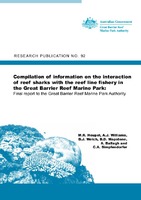Please use this identifier to cite or link to this item:
https://hdl.handle.net/11017/420

Full metadata record
| DC Field | Value | Language |
|---|---|---|
| dc.contributor.author | Heupel, M.R. | * |
| dc.contributor.author | Williams, A.J. | * |
| dc.contributor.author | Welch, D.J. | * |
| dc.contributor.author | Mapstone, B.D. | * |
| dc.contributor.author | Ballagh, A. | * |
| dc.contributor.author | Simpfendorfer, C.A. | * |
| dc.date.accessioned | 2012-05-25T02:50:40Z | en |
| dc.date.available | 2012-05-25T02:50:40Z | en |
| dc.date.copyright | 2008 | en |
| dc.date.issued | 2008 | en-US |
| dc.identifier.isbn | 9781876945763 | en |
| dc.identifier.uri | https://hdl.handle.net/11017/420 | en |
| dc.description.abstract | Three data sets were examined to define the level of interaction of reef associated sharks with the commercial Coral Reef Fin Fish Fishery (CRFFF) within the Great Barrier Reef. Data were examined from; 1) fishery logbooks from 1989-2006; 2) an observer program within the fishery from 1996-1998; and 3) a fishery-independent survey, the Effects of Line Fishing (ELF) Experiment conducted from 1995-2005. The majority of the identified catch in the data sets was comprised of grey reef (62-72%), whitetip reef (16-29%) and blacktip reef (6-13%) sharks. Logbook data were inadequate for assessing the impact of the fishery on specific populations due to lack of species identification and sex or size data for landed sharks. In addition, no data were recorded in logbooks for hooked and released sharks. Logbook catch data revealed that reported landings of sharks were variable through time and across regions. Despite the observed variation, catch per unit effort was relatively stable through time and did not show any signs of increase or decline over the period for which data were available. The ongoing and consistent catches of reef sharks in the fishery may indicate that shark populations within the Great Barrier Reef Marine Park have remained relatively stable during the last two decades, though population status relative to unexploited levels could not be estimated. Although the CRFFF has a large fleet of vessels, the majority of shark catch appears to be landed by a small number of vessels. | en |
| dc.language.iso | en | en |
| dc.publisher | Great Barrier Reef Marine Park Authority | en |
| dc.relation.ispartofseries | Research publication series no. 92 | en |
| dc.relation.ispartofseries | Research publication | - |
| dc.relation.ispartofseries | Report to the Great Barrier Reef Marine Park Authority | - |
| dc.subject | Sharks | en |
| dc.subject | Fisheries | en |
| dc.title | Compilation of information on the interaction of reef sharks with the reef line fishery in the Great Barrier Reef Marine Park final report to the Great Barrier Reef Marine Park Authority. | en |
| dc.type | Report | en |
| dc.subject.asfa | Shark fisheries | en |
| dc.subject.asfa | Line fishing | en |
| dc.subject.asfa | Coral reefs | en |
| dc.subject.asfa | Predators | en |
| dc.subject.asfa | Commercial fishing | en |
| dc.format.pages | 48 | en |
| dc.contributor.corpauthor | Great Barrier Reef Marine Park Authority | en |
| dc.subject.apais | Fisheries | en |
| dc.subject.apais | Environmental management | en |
| dc.publisher.place | Townsville | en |
| dc.relation.connectiontogbrmpa | GBRMPA published this item | en |
| dc.subject.category | Animals | en |
| dc.subject.category | Commercial fisheries | en |
| dc.subject.category | Research | en |
| dc.subject.theme | Managing Multiple Use | en |
| dc.subject.theme | Reef Ecosystems and Species | en |
| dc.keywords | reef sharks | en |
| dc.keywords | CRFFF | en |
| Appears in Collections: | Ecosystems | |
Files in This Item:
| File | Description | Size | Format | |
|---|---|---|---|---|
| Compilation-information-interaction-reef-sharks-with-reef-line-fishery.pdf | 801.55 kB | Adobe PDF |  View/Open |
Items in ELibrary are protected by copyright, with all rights reserved, unless otherwise indicated.
